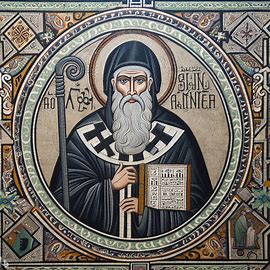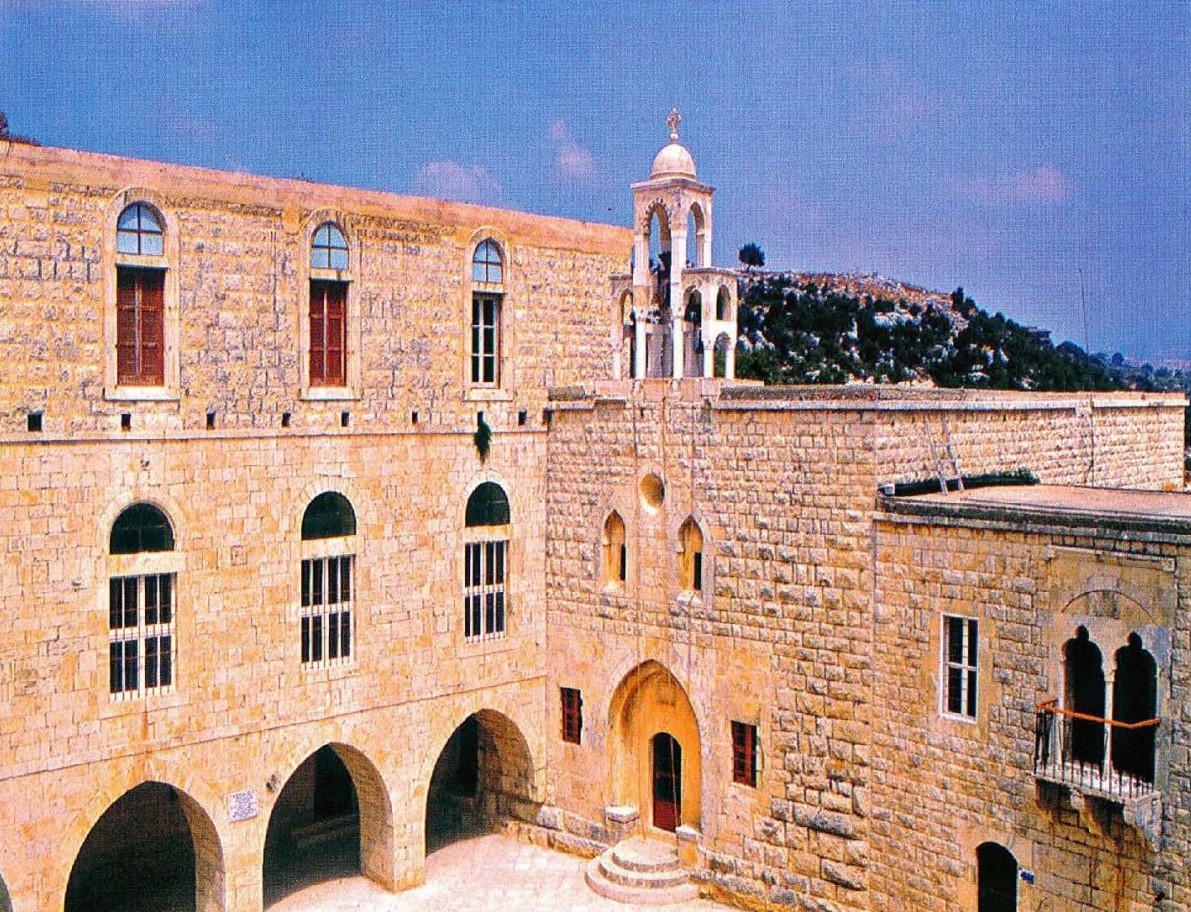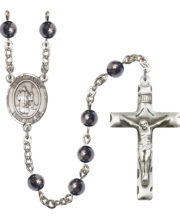Saints
St. Maron
St. Maron Biography
 St. Maron was a Christian monk and theologian who is revered as the patron saint of the Maronite Church, an Eastern Catholic Church in full communion with the Roman Catholic Church. He was born in the early 4th century in present-day Syria, and he received a classical education in theology, philosophy, and literature. After completing his studies, he withdrew from society and devoted himself to a life of asceticism and contemplation.
St. Maron was a Christian monk and theologian who is revered as the patron saint of the Maronite Church, an Eastern Catholic Church in full communion with the Roman Catholic Church. He was born in the early 4th century in present-day Syria, and he received a classical education in theology, philosophy, and literature. After completing his studies, he withdrew from society and devoted himself to a life of asceticism and contemplation.
St. Maron was born in Syria Prima (modern-day Syria) in the middle of the 4th century AD, during the reign of Constantine the Great, the first Roman emperor to legalize Christianity. The exact date and place of his birth are unknown, but some sources suggest that he was born in Cyrrhus, a small town near Antioch, which was then the third largest city in the Roman Empire and a center of Christian learning and culture. He came from a noble family and received a good education in classical languages and literature. He was baptized and converted to Christianity at a young age, and felt a strong call to dedicate his life to God.
Maron lived in a small cell near the Orontes River, where he practiced extreme forms of self-denial and mortification. He was known for his austere lifestyle and his devotion to prayer and meditation. Despite his isolation, Maron became well-known for his wisdom and his spiritual insight, and he attracted a large following of devoted disciples.
In the early 5th century, Maron was ordained a priest and established a monastic community near his cell. This community, known as the Monastery of St. Maron, became a center of learning and spiritual formation for monks and laypeople alike. Maron’s influence spread throughout the region, and he is credited with revitalizing monasticism in Syria and Lebanon.
St. Maron decided to become a hermit, following the example of St. Anthony of Egypt, the founder of Christian monasticism. He left his family and worldly possessions and ascended to the top of Mount Nabo (also called Mount Taurus or Mount Ol-Yambos), where he lived outdoors exposed to the elements of nature such as sun, rain, hail, and snow. He practiced severe asceticism, fasting, praying, meditating, and working with his hands. He wore simple clothes made of animal skins or sackcloth, slept on the ground or on a rock, ate only bread and water or herbs and fruits, and abstained from wine and meat. He also performed many miracles by the power of God, such as healing the sick, exorcising demons, multiplying food, calming storms, and raising the dead.
Maron’s teachings emphasized the importance of humility, charity, and obedience to God’s will. He believed that true spiritual growth could only be achieved through a life of asceticism and self-denial. He also emphasized the importance of the Eucharist and the role of the Church in the spiritual life of believers.
Maron’s influence continued to grow after his death, and he was eventually canonized as a saint by the Maronite Church. The feast day of St. Maron is celebrated on February 9th. St. Matron is revered as a patron saint of the Maronite Church and a model of monastic piety.
Throughout the centuries, St. Maron has been revered as a spiritual leader and a source of inspiration for the Maronite Church. His teachings and example continue to influence the Church today, and he is remembered as one of the great figures of Christian history.
Popular St. Maron Medal and St. Maron Rosary
Prayers to St. Maron
Prayer of Intercession to St. Maron
Dear St. Maron, I come to you today seeking your intercession and guidance. I know that you are a powerful advocate in heaven, and I ask for your help in bringing my petitions before God.
Please pray for me and for all those who are dear to me, that we may receive the grace and strength we need to face the challenges and struggles of life. Help us to trust in God’s love and to find peace in his care.
I pray that through your intercession, we may be blessed with the gifts of faith, hope, and love, and that we may grow closer to God each day. Amen.
Prayer to St. Maron for Courage
St. Maron, you were a man of great courage and faith, and you were not afraid to speak the truth, even in the face of persecution. I ask for your intercession as I seek the courage to follow your example.
Help me to stand firm in my faith, even when it is difficult or unpopular. Give me the strength to speak out for what is right and to defend the truth, even when it is hard.
I pray that through your example and your intercession, I may be strengthened in my faith and may have the courage to live for God no matter what comes my way
Traditional Prayer to Saint Maron
O God, who in your kindness called your holy servant Maron to the following of Christ, grant, we pray, through his intercession, that, denying ourselves, we may hold fast to you with all our heart. O Lord, accept the prayers we offer in memory of our Father, St. Maron. Bless and protect the people who bear your name. Make us worthy of his holy legacy that we may carry the message of your Gospel throughout the world. Grant faithfulness to his people and courage to his inheritance. Through our Lord Jesus Christ, your Son, who lives and reigns with you in the unity of the Holy Spirit, one God, for ever and ever. Amen.
Quotes by St. Maron
- “Let your heart be filled with love for all humanity, for this is the way of Christ.”
- “Prayer is the key that unlocks the heart of God.”
- “Faith is the cornerstone upon which our lives are built. Without faith, we are lost in the darkness.”
- “True devotion to God is not just about words and rituals, but about living a life of compassion, humility, and love.”
- “The greatest joy in life is to be in the presence of God and to do His will.”
Children’s Story about the life of St. Maron
One day, in a small village in the mountains, there lived a kind and gentle man named Maron. Maron was a devoted follower of Jesus and spent his days helping the poor and sick. He was loved by all who knew him, and his heart was full of love and compassion for others.
One day, a terrible sickness swept through the village, and many people became very sick. Maron worked tirelessly to care for the sick and comfort the dying, and he prayed to God for help.
Through his faith and hard work, Maron was able to heal many of the sick, and the villagers were grateful to him. They saw the great love and compassion that Maron had for others, and they knew that he was a special person, chosen by God to do great things.
As Maron grew older, he became a respected leader in the village, and his wisdom and kindness were sought out by all. He dedicated his life to helping others, and he became known as St. Maron, a patron saint of the village.
To this day, St. Maron is remembered and loved by the villagers, who are grateful for all that he did to help and heal them. His legacy of love and compassion lives on, inspiring people everywhere to be kind and help those in need.
Reflection on the Feast of St. Maron
Today, the Catholic Church celebrates the feast of St. Maron on February 9th.
On the Feast of St. Maron, it is important to remember and honor this important figure in the Maronite Church. St. Maron is the spiritual father of the Maronite Church and lived around 350 to 423 AD in modern-day Syria. He lived on a mountaintop, with no shelter other than a small tent, and dedicated himself to prayer and the practice of philosophy. St. Maron was also known for his ability to heal, both physical ailments and spiritual ones, and his fame spread throughout the region. He is remembered for his devotion to God and his selfless service to others. On this feast day, we give thanks for the life and example of St. Maron and pray for his intercession.
What is the Maronite Church
The Maronite Church is an Eastern Catholic Church that follows the Antiochian Rite and is in full communion with the Holy See. It is one of the 22 Eastern Catholic Churches in the Catholic Church and is the largest of the Eastern Catholic Churches in the Middle East. The Maronite Church has its roots in the 4th century, when the monk St. Maron founded a monastic movement in the region of Antioch (present-day Turkey). Today, the Maronite Church is centered in Lebanon and has a significant presence in other countries around the world, including the United States, Canada, Australia, and Latin America. The Maronite Church is known for its strong devotion to Mary, the mother of Jesus, and has a rich liturgical tradition that includes the use of the Syriac language in its liturgies.
6 Things You Should Know about the Maronite Church
- The Maronites are Antiochene. This means that they trace their origins to the ancient city of Antioch, where the followers of Jesus were first called Christians (Acts 11:26). Antioch was a major center of learning and culture in the Roman Empire, and it was also the place where many important theological debates took place. The Maronites inherited the rich spiritual and intellectual legacy of Antioch, which shaped their liturgy, theology, and spirituality.
- The Maronites are heirs of Syriac cultural and religious heritage. Syriac is a dialect of Aramaic, the language that Jesus spoke. Syriac was widely used by Christians in the Middle East, especially in Syria, Mesopotamia, and Persia. Syriac literature is one of the oldest and most diverse in Christianity, containing works of poetry, hymnography, mysticism, philosophy, and theology. The Maronites preserved and developed the Syriac tradition, using it as their liturgical and literary language until modern times.
- The Maronites are Chalcedonian. This means that they adhere to the teachings of the Council of Chalcedon, which was held in 451 A.D. The Council affirmed that Jesus Christ is one person with two natures: divine and human. This doctrine was challenged by some groups who either denied the full humanity or the full divinity of Christ. The Maronites were among the strongest defenders of Chalcedonian orthodoxy, resisting any attempts to compromise or alter the faith handed down by the apostles.
- The Maronite Church is a Patriarchal and Monastic Church. The Maronite Church is led by a Patriarch, who is the spiritual father and head of all Maronites. The Patriarch is elected by the bishops and confirmed by the Pope. The Patriarch has his seat in Bkerke, Lebanon, where he resides with his synod of bishops. The Maronite Church also has a strong monastic tradition, dating back to the fourth century, when St. Maron founded a community of hermits in Syria. St. Maron is considered the founder and patron saint of the Maronite Church. His disciples spread his teachings and way of life throughout the region, attracting many followers and forming monasteries.
- The Maronite Church is Catholic, in full communion with the Apostolic See of Peter in Rome. The Maronites have always maintained their loyalty and fidelity to the Pope, as a sign of their unity with the universal Church. The Maronites have also enriched the Catholic Church with their unique spirituality, liturgy, and culture. The Maronite Church is one of the 23 Eastern Catholic Churches that are in communion with Rome, but have their own rites and traditions.
- The Maronite Church is tied to Lebanon, her spiritual homeland and the residence of her Patriarch. Lebanon is a small country in the Middle East, bordered by Syria, Israel, and the Mediterranean Sea. Lebanon has a diverse population of different religions and ethnicities, including Christians, Muslims, Druze, Armenians, Kurds, and others. Lebanon is also home to about four million Maronites, who make up about a quarter of the population. The Maronites have played a significant role in the history and politics of Lebanon, contributing to its culture, education, economy, and social life. The Maronites have also faced many challenges and hardships in Lebanon, such as wars, invasions, persecution, and displacement. Despite these difficulties, the Maronites have remained faithful to their identity and mission as witnesses of Christ in their homeland.

Maronite Churches and Missions in the United States
- Our Lady’s Maronite Church – Austin, Texas
- Our Lady of Lebanon – Easton, Pennsylvania
- Our Lady of Lebanon – Flint, Michigan
- Our Lady of Lebanon – Lewisville, Texas
- Our Lady of Lebanon – Lombard (Chicago), Illinois
- Our Lady of Lebanon – Miami, Florida
- Our Lady of Lebanon – San Francisco (Milbrae), California
- Our Lady of Lebanon – Washington, D.C.
- Our Lady of Lebanon – Waterbury, Connecticut
- Our Lady of Lebanon – Wheeling, West Virginia
- Our Lady of Lebanon Maronite Mission – Columbus, Ohio
- St. Anthony Maronite Church – Glen Allen, Virginia
- St. Anthony Maronite Church – Lawrence, Massachusetts
- St. Anthony of Padua – Cincinnati, Ohio
- St. Anthony/St. George Maronite Church: Wilkes-Barre, Pennsylvania
- St. Elias Maronite Church – Birmingham, Alabama
- St. Elias Maronite Church – Roanoke, Virginia
- St. Ephrem Maronite Church – El Cajon, California
- St. George Maronite Church – Uniontown, Pennsylvania
- St. George Maronite Church – San Antonio, Texas
- St. John the Baptist Maronite Church – New Castle, Pennsylvania
- St. John Maron Church – Anaheim, California
- St. John Maron Maronite Church: Williamsville, (Buffalo) New York
- St. Joseph Maronite Church – Atlanta, Ga.
- St. Joseph Maronite Church – Phoenix, Arizona
- St. Joseph Maronite Church – Waterville, Maine
- St. Jude Maronite Church – Murray, Utah
- St. Jude Maronite Church – Orlando, Florida
- St. Jude the Apostle -Westlake Village, California
- St. Maron Church – Cleveland, Ohio
- St. Maron Church – Minneapolis, Minnesota
- St. Maron Church – Torrington, Connecticut
- St. Maron Church – Youngstown, Ohio
- St. Sharbel Maronite Church – Warren, Michigan
You may also be interested in learning about St. Rafqa


